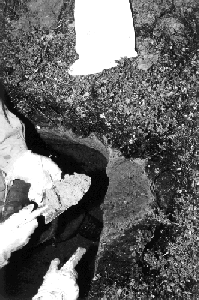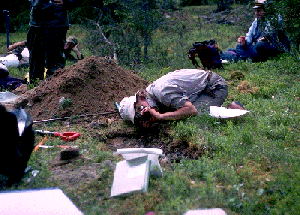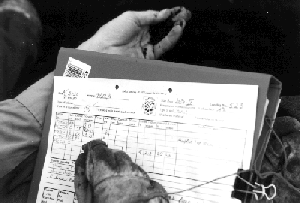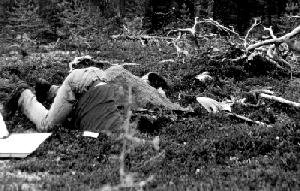Podzol Horizons
Rationale
Soils are the interface between the atmosphere, biosphere, hydrosphere
and geosphere, and their chemical composition is affected by all
these. By taking several samples along a vertical profile in a
dug pit or a trench, one can study the transition between the
influence of all the above compartments. Podzols (Fig. 1) are a particular
type of soil, where drainage, vegetation and mineral weathering
characteristics impart a typical layering, consisting from top
to bottom of the O (humus or organic), E (elluvial or bleached),
B (illuvial or accumulative), B/C (intermediate between B and
C) and C-horizons (weakly altered, unconsolidated parent material).
By comparing the regional patterns of composition of the O and
C-horizons, one can gain insights into the relative importance
of natural versus anthropogenic processes in an area.
Advantages
Gives vertical profiles and 3-D pictures of element composition,
from where processes may be deduced.
Drawbacks
Requires specialist to select site, collect samples (Figs. 2-6)
and interpret results.
Soil pit digging is strenuous, time consuming, thus expensive!
PODZOL PROFILE
![[cd2-22]](/Kola/cd2-22_.gif)
(Photo: C. Reimann)
Fig. 1: The dug hole reveals a beautiful, typical podzol profile with its
colourful horizons.
|
SAMPLING THE DIFFERENT HORIZONS

(Photo: C. Reimann)
Fig. 2: The different podzol horizons are sampled sequentially from
bottom to top of the soil pit.
|
STUDY OF THE SOIL PIT

(Photo: C. Reimann)
Fig. 3: The podzol profile is carefully described, photographed and sampled.
|
FIELD SHEET

(Photo: C. Reimann)
Fig. 4: Important details of the podzol horizons are recorded on a special
field sheet.
|
PODZOL PROFILE INVESTIGATION, METHOD A
![[cd2-21]](/Kola/cd2-21_.gif)
(Photo: C. Reimann)
Fig. 5: The gopher technique...
|
PODZOL PROFILE INVESTIGATION, METHOD B

(Photo: C. Reimann)
Fig. 6: The ostrich technique...
|



![[cd2-22]](/Kola/cd2-22_.gif)



![[cd2-21]](/Kola/cd2-21_.gif)



